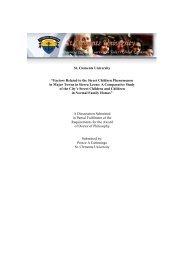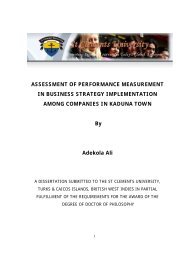The role of informal microfinance institutions in saving
The role of informal microfinance institutions in saving
The role of informal microfinance institutions in saving
You also want an ePaper? Increase the reach of your titles
YUMPU automatically turns print PDFs into web optimized ePapers that Google loves.
the field conditions which were the operat<strong>in</strong>g environment <strong>of</strong> the various subsystems<br />
identified <strong>in</strong> the conceptual model.<br />
<strong>The</strong> research was designed to meet the various groups <strong>of</strong> people such as research and<br />
development <strong><strong>in</strong>stitutions</strong>, senior personnel <strong>in</strong> the bank<strong>in</strong>g <strong>in</strong>dustry, Micr<strong>of</strong><strong>in</strong>ance <strong><strong>in</strong>stitutions</strong>,<br />
Managers and owners <strong>of</strong> SACCOs, <strong>in</strong>dividuals/ stakeholders <strong>of</strong> SACCOs.<br />
<strong>The</strong> study will be expected to be taken further <strong>in</strong> a place where a number <strong>of</strong> activities to<br />
promote the use <strong>of</strong> Sacco’s services /products are to be implemented and useful and where the<br />
f<strong>in</strong>ancial support services to SACCOs <strong>in</strong> Tanzania and where the bus<strong>in</strong>ess development support<br />
services needed by SACCOs and provided by support <strong><strong>in</strong>stitutions</strong> are highly needed.<br />
Why? Enables a researcher to discuss his problems with his colleagues and others who have<br />
enough experience <strong>in</strong> the same area or <strong>in</strong> work<strong>in</strong>g on similar problems.<br />
4. How is the data to be collected?<br />
<strong>The</strong> task <strong>of</strong> data collections beg<strong>in</strong>s after a research problem has been def<strong>in</strong>ed and research<br />
design/ plan chalked out. While decid<strong>in</strong>g about the method <strong>of</strong> data collection to be used for<br />
the study. <strong>The</strong> special data gather<strong>in</strong>g techniques utilized group-based techniques s<strong>in</strong>ce<br />
<strong>in</strong>volved those who first raised the problem and the researcher enter <strong>in</strong>to discussion with those<br />
who have a good knowledge <strong>of</strong> the problem concerned or similar other problems keep <strong>in</strong><br />
view the environment with<strong>in</strong> which the problems is to be studied and understood. <strong>The</strong><br />
researcher should take <strong>in</strong>to considerations two types <strong>of</strong> data collection namely primary and<br />
secondary data.<br />
<strong>The</strong> primary data – are those which are collected a fresh and for the first time and thus happen<br />
to be orig<strong>in</strong>al <strong>in</strong> character, this can be done through surveys, census, observation or through<br />
observation or through direct communication with respondents <strong>in</strong> one form or another or<br />
through personal <strong>in</strong>terviews<br />
Secondary Data – Are those which have already been collected by someone else and which<br />
have been passed through the statistical process. <strong>The</strong> researcher will have to select one or<br />
other method <strong>of</strong> data collection.<br />
170
















